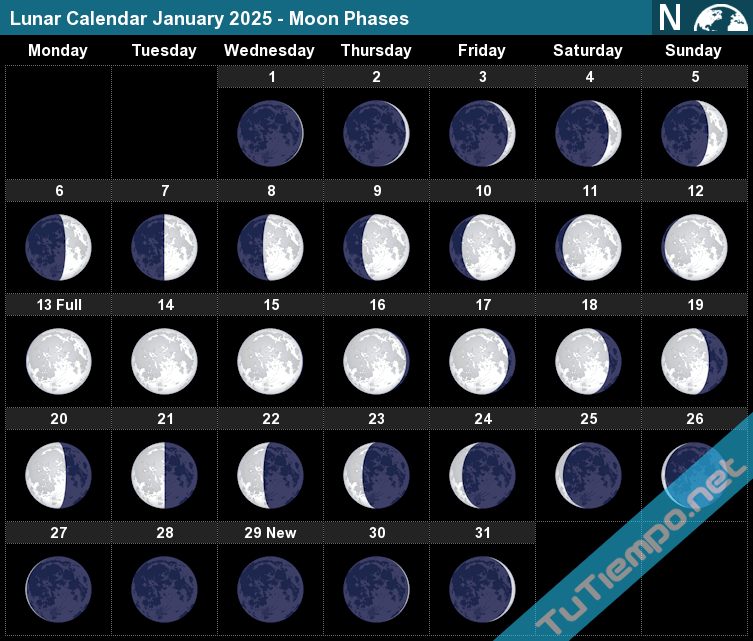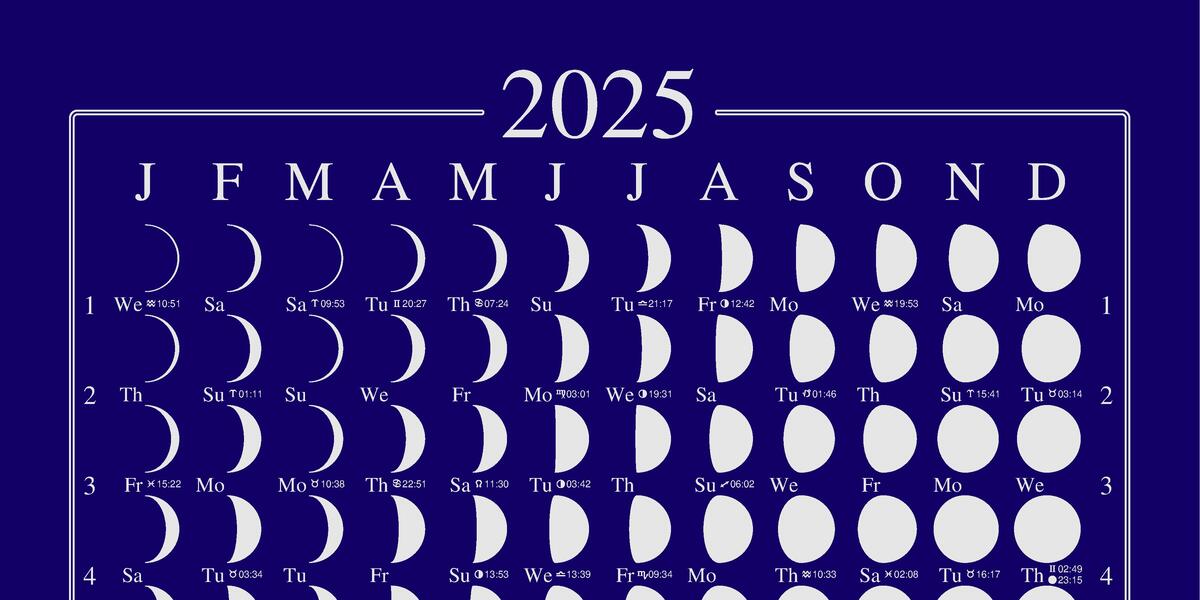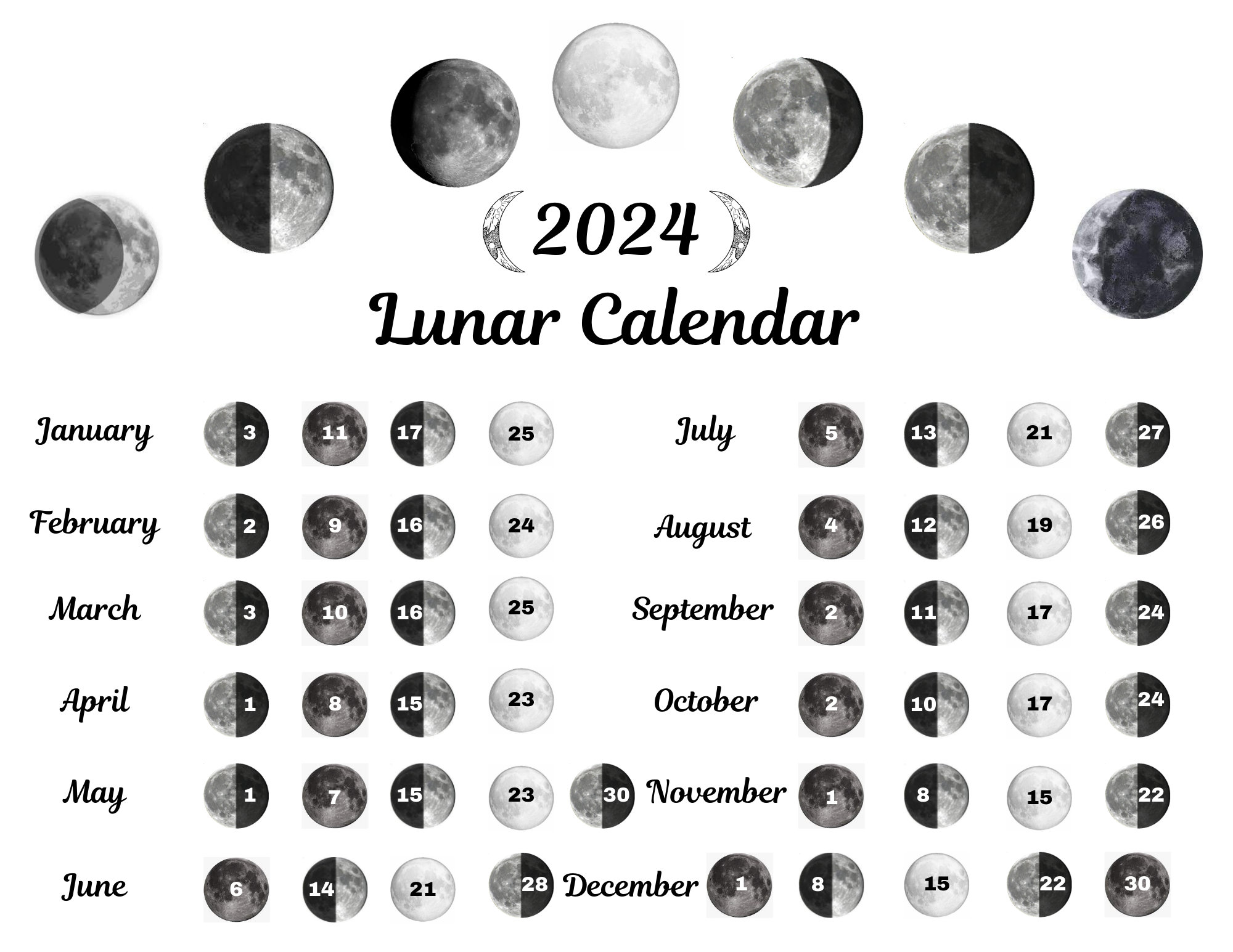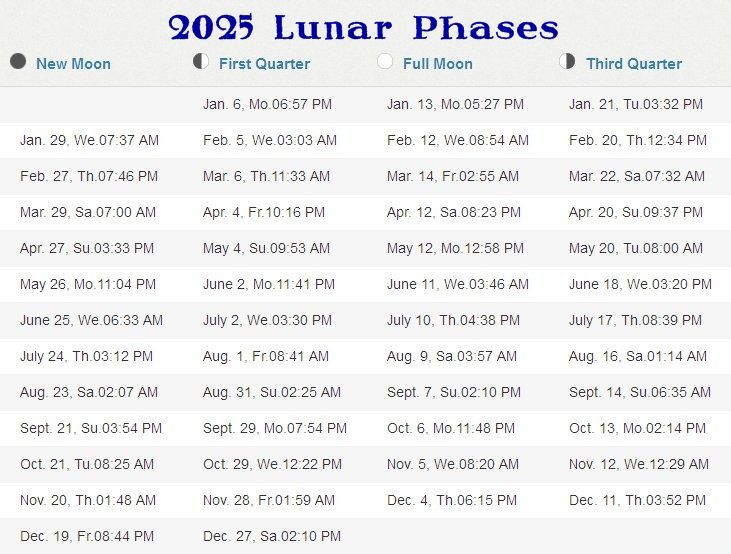Embark on a celestial journey with our comprehensive Full Moon Calendar 2025. Discover the dates and times of every full moon, explore their astrological significance, and delve into the cultural traditions and scientific impact surrounding these celestial marvels.
Prepare to be captivated by the enchanting beauty of full moons, unravel their mystical allure, and gain a deeper understanding of their influence on our world.
Lunar Calendar Data

The lunar calendar is a type of calendar that is based on the cycles of the Moon. The full moon is the phase of the Moon when the entire face of the Moon is illuminated by the Sun. In 2025, there will be 12 full moons.
The following table shows the dates and times of the full moons in 2025, along with any notable astronomical events that will coincide with the full moons.
Full Moon Dates and Times
| Date | Time (UTC) | Notable Astronomical Events |
|---|---|---|
| January 6 | 04:08 | None |
| February 5 | 11:28 | None |
| March 7 | 18:33 | None |
| April 5 | 01:54 | None |
| May 5 | 10:05 | None |
| June 3 | 17:12 | None |
| July 3 | 00:38 | None |
| August 1 | 09:10 | None |
| August 30 | 16:37 | None |
| September 29 | 00:33 | None |
| October 28 | 09:24 | None |
| November 27 | 16:44 | None |
Astrological Significance
Full moons are significant astrological events that hold immense influence on the emotional, spiritual, and physical aspects of our lives. Their potent energy can amplify emotions, trigger spiritual awakenings, and impact our overall well-being.
Each full moon aligns with a specific zodiac sign, imbuing it with unique characteristics and effects. Understanding the astrological significance of full moons allows us to harness their transformative power and navigate their potential challenges.
Emotional Effects
Full moons often intensify emotions, making us more sensitive and reactive. This can lead to heightened intuition and a deeper understanding of our inner selves. However, it can also trigger emotional outbursts, mood swings, and a sense of vulnerability.
Spiritual Effects
Full moons provide an opportunity for spiritual growth and reflection. They illuminate hidden truths, facilitate inner healing, and enhance our connection to the divine. This energy can support meditation, introspection, and the release of negative patterns.
Physical Effects
Full moons can influence our physical well-being. Some people experience increased energy levels, while others may feel drained. It’s important to listen to your body and adjust your activities accordingly. Additionally, full moons can affect sleep patterns, so it’s recommended to establish a consistent sleep routine.
Zodiac Sign Influence
The zodiac sign that a full moon aligns with plays a significant role in its effects. For example, a full moon in Aries can bring a surge of energy and passion, while a full moon in Pisces may foster introspection and emotional sensitivity.
Cultural Observances

Full moons have held cultural significance in societies across the globe, inspiring traditions and rituals that celebrate, honor, and harness the perceived power of the lunar cycle.
These cultural observances reflect the diverse beliefs, customs, and folklore associated with the full moon, offering insights into the rich tapestry of human experiences and connections to the natural world.
Indigenous Traditions
- Native American Cultures:Many Native American tribes hold ceremonies and rituals under the full moon, honoring its spiritual significance and seeking guidance from the lunar spirits.
- Australian Aboriginal Cultures:The full moon is a time for gathering, storytelling, and ceremonies, connecting to the ancestral spirits and celebrating the lunar cycle.
- Polynesian Cultures:The full moon is associated with fertility and abundance, and rituals are performed to honor the lunar deities and promote prosperity.
Religious Observances
- Hinduism:The full moon is known as “Purnima” and is considered a sacred time for worship and spiritual practices.
- Buddhism:The full moon is celebrated as “Uposatha” and is a day of observance, meditation, and teachings.
- Islam:The full moon marks the end of the Islamic month and is a time for reflection and gratitude.
Festivals and Folklore
- Mid-Autumn Festival (China):Celebrated during the full moon in September, this festival involves mooncakes, lanterns, and family gatherings.
- Diwali (India):The festival of lights coincides with the full moon in October or November, symbolizing the triumph of good over evil.
- Harvest Moon Festival (Europe):Traditionally celebrated on the full moon closest to the autumn equinox, this festival marks the end of the harvest season.
Scientific Impact
Full moons have significant scientific implications, influencing both Earth’s physical processes and potentially human behavior.
The gravitational pull of the Moon exerts a strong influence on Earth’s tides. During a full moon, the Moon’s gravitational force combines with the Sun’s, resulting in higher high tides and lower low tides, known as spring tides.
If you’re interested in the full moon calendar for 2025, you can also check out the alief isd calendar for school closures and important dates. This calendar can be a useful resource for planning events and activities around the full moon.
Lunar Cycle and Earth’s Orbit
The lunar cycle is closely linked to the Earth’s rotation and orbit around the Sun. The Moon’s orbit around Earth takes approximately 27.3 days, while Earth’s orbit around the Sun takes 365.25 days.
The Moon’s position relative to the Earth and the Sun determines the phase of the Moon we observe. During a full moon, the Moon is on the opposite side of the Earth from the Sun, fully illuminated by sunlight.
Folklore and Mythology

Full moons have captured the imagination of humans for centuries, inspiring countless stories, legends, and beliefs. Across cultures and historical periods, they have been associated with everything from supernatural transformations to divine guidance.
In many cultures, full moons were believed to bring out the supernatural. In ancient Greece, for example, it was said that the goddess Artemis, associated with the moon, would appear during the full moon to guide travelers and protect them from harm.
In Native American folklore, full moons were seen as a time of increased spiritual power, when animals could speak and spirits could walk the earth.
Werewolves and Lycanthropy
One of the most enduring myths associated with full moons is the belief that they can transform humans into werewolves. This legend originated in ancient Greece, where it was said that those bitten by a werewolf during a full moon would themselves become werewolves.
The myth has persisted through the centuries, inspiring countless stories, movies, and television shows.
Photography Tips: Full Moon Calendar 2025

Capturing stunning photographs of the full moon requires specific techniques and considerations. Here’s a guide to help you achieve captivating lunar shots:
Choose the right camera settings. Use a tripod for stability and set the ISO to around 200-400 for low noise. Adjust the aperture to f/8 or f/11 for a sharp image, and experiment with shutter speeds between 1/125 and 1/250 second to avoid overexposure.
Lens Choice, Full moon calendar 2025
A telephoto lens with a focal length of 200mm or more is ideal for magnifying the moon’s details. If using a shorter lens, crop the image in post-processing to enhance the moon’s size.
Composition
Consider the moon’s position in the frame and experiment with different angles and perspectives. Incorporate foreground elements like trees or buildings to add depth and context to your shots.
Health and Wellness
Full moons have been associated with various health and wellness implications, including their potential impact on sleep patterns, mood, and energy levels.
Research suggests that the gravitational pull of the moon during a full moon can affect the body’s natural circadian rhythms, leading to disrupted sleep and difficulty falling or staying asleep.
Sleep Patterns
- Studies have shown that during a full moon, individuals may experience reduced sleep efficiency, shorter sleep duration, and increased wakefulness.
- The bright moonlight can interfere with melatonin production, a hormone that promotes sleep.
Mood and Energy Levels
- Some individuals report feeling more emotionally sensitive or irritable during a full moon.
- Fluctuations in sleep patterns can also impact mood and energy levels, leading to fatigue and difficulty concentrating.
Tips for Managing Health Implications
- Establish a regular sleep-wake cycle, even on nights with a full moon.
- Create a dark and relaxing sleep environment by using blackout curtains or an eye mask.
- Avoid caffeine and alcohol before bed.
- Engage in stress-reducing activities such as yoga, meditation, or reading.
Gardening and Agriculture

The full moon’s gravitational pull influences the Earth’s tides and plant growth. Understanding these lunar cycles can help gardeners and farmers optimize their practices for better yields and plant health.
Planting and Harvesting Schedules
Planting during a waxing moon (from new moon to full moon) encourages above-ground growth, making it ideal for leafy vegetables, herbs, and flowers. Harvesting during a waning moon (from full moon to new moon) supports root development, making it suitable for root vegetables, bulbs, and tubers.
Specific Lunar Influences
* New Moon:Favorable for planting seeds and starting new plants.
Waxing Crescent Moon
Good for transplanting and cultivating above-ground growth.
First Quarter Moon
Ideal for pest control and fertilizing.
Waxing Gibbous Moon
Excellent for planting and harvesting fruits and flowers.
Full Moon
Peak growth period, avoid pruning or transplanting.
Waning Gibbous Moon
If you’re planning your 2025 events around the full moon, check out the full moon calendar for that year. For those interested in the seminole county public schools calendar , it’s also available online. And don’t forget to mark your calendars for the full moons in 2025!
Good for harvesting root vegetables and pruning.
Third Quarter Moon
Suitable for pest control and weeding.
Waning Crescent Moon
Ideal for harvesting leafy vegetables and herbs.
Additional Considerations
* Moon’s position in the zodiac can also influence plant growth. For example, planting during an Aries moon is said to promote vitality and growth.
- Combining lunar cycles with other factors like soil conditions, climate, and plant species is essential for optimal results.
- Observing lunar cycles and experimenting with different planting and harvesting times can help gardeners and farmers refine their practices and maximize their yields.
Moon Phases

The moon goes through a cycle of phases as it orbits the Earth. These phases are determined by the position of the moon relative to the sun and the Earth, and they affect the amount of sunlight that is reflected back to us.
The main phases of the moon are the new moon, waxing crescent, first quarter, waxing gibbous, full moon, waning gibbous, third quarter, and waning crescent. The new moon occurs when the moon is between the Earth and the sun, and the side of the moon that is facing us is not illuminated.
The waxing crescent occurs when the moon is moving away from the sun, and a small sliver of the moon is illuminated. The first quarter occurs when the moon is at a right angle to the sun, and half of the moon is illuminated.
The waxing gibbous occurs when the moon is moving closer to the sun, and more than half of the moon is illuminated. The full moon occurs when the moon is opposite the sun, and the entire side of the moon that is facing us is illuminated.
The waning gibbous occurs when the moon is moving away from the sun, and more than half of the moon is illuminated. The third quarter occurs when the moon is at a right angle to the sun, and half of the moon is illuminated.
The waning crescent occurs when the moon is moving closer to the sun, and a small sliver of the moon is illuminated.
Scientific Processes
The changing appearance of the moon is caused by the way that sunlight reflects off of the moon’s surface. When the moon is between the Earth and the sun, the side of the moon that is facing us is not illuminated, and we see a new moon.
As the moon moves away from the sun, more and more of the moon’s surface is illuminated, and we see a waxing crescent. When the moon is at a right angle to the sun, half of the moon is illuminated, and we see a first quarter.
As the moon moves closer to the sun, more than half of the moon is illuminated, and we see a waxing gibbous. When the moon is opposite the sun, the entire side of the moon that is facing us is illuminated, and we see a full moon.
As the moon moves away from the sun, less and less of the moon’s surface is illuminated, and we see a waning gibbous. When the moon is at a right angle to the sun, half of the moon is illuminated, and we see a third quarter.
As the moon moves closer to the sun, less than half of the moon is illuminated, and we see a waning crescent.
Notable Full Moons
Throughout history, certain full moons have garnered attention due to their unique characteristics or astronomical significance. These include supermoons, blue moons, and lunar eclipses, each offering a distinct spectacle in the night sky.
Supermoons occur when the full moon coincides with the moon’s closest approach to Earth in its orbit, resulting in an apparent increase in its size and brightness. Blue moons, on the other hand, are the second full moon within a calendar month, a relatively rare occurrence that happens approximately every two and a half years.
Lunar Eclipses
Lunar eclipses transpire when the Earth moves between the sun and the moon, casting a shadow on the moon’s surface. Total lunar eclipses occur when the entire moon falls within the Earth’s shadow, creating a breathtaking spectacle of a blood-red moon.
- In 2025, a total lunar eclipse will occur on March 14th, visible from North and South America, Europe, and Africa.
- Another total lunar eclipse is expected on September 8th, 2025, and will be visible from Asia, Australia, and parts of Africa.
Visual Representation
To enhance the accessibility and visual appeal of the 2025 Full Moon Calendar, we recommend creating an infographic or chart that summarizes the key information in an engaging and easy-to-understand format. This visual representation can effectively convey data from the lunar calendar, astrological significance, and cultural observances.
The infographic or chart should be visually appealing and clearly organized, allowing users to quickly grasp the information they seek. It can include elements such as:
Data from the Lunar Calendar
- Dates and times of full moons in 2025
- Moon’s position in the zodiac
- Moon’s phase and illumination percentage
Astrological Significance
- Astrological sign associated with each full moon
- Planets and aspects influencing the full moon
- Overall astrological themes and energies
Cultural Observances
- Traditional names and folklore associated with each full moon
- Cultural festivals or rituals related to the full moon
- Historical events or milestones that coincide with full moons
By combining these elements into a visually appealing infographic or chart, you can create a valuable resource that makes the information in the 2025 Full Moon Calendar accessible and engaging to a wide audience.
FAQ
What is the significance of a full moon?
A full moon occurs when the Earth is positioned directly between the sun and the moon, causing the moon’s entire face to be illuminated by sunlight.
How does the full moon affect the tides?
The gravitational pull of the full moon, combined with that of the sun, creates higher high tides and lower low tides, known as spring tides.
What are some cultural traditions associated with full moons?
Full moons have been celebrated and revered in many cultures throughout history, with traditions ranging from festivals and rituals to storytelling and folklore.